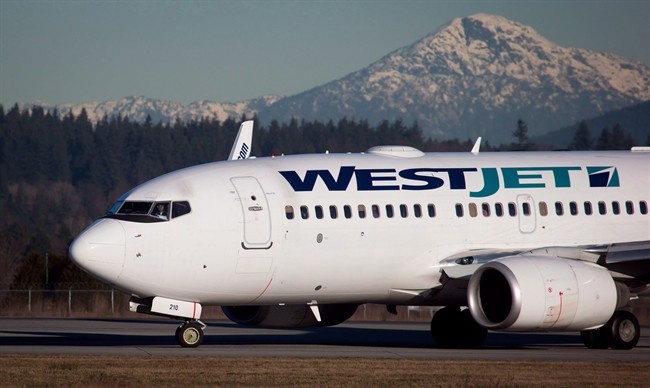WestJet Airlines is considering adding another row of seats on its planes to drive higher revenues after it puts in a new entertainment system over the next two years.

Chief executive Gregg Saretsky said Tuesday that passengers won’t notice any change in legroom after it installs new slim-line seats equipped with the Wi-Fi system, which give an extra inch of legroom.
“The impact on our brand is going to be positive because we’re going to provide more features for our guests… and the opportunity to densify the fleet gives (us) a chance to further reduce our fares,” Saretsky said after the company reported its third-quarter results.
“So everything that we’re doing is with the mindset of how do we keep dropping fares in Canada. We haven’t given up on continuing to scratch away at other ideas to do that without compromising the brand.”
READ MORE: WestJet to offer lower airfares for ‘some’ economy fliers
About half of WestJet’s mainline fleet will get the new seats next year with the rest in 2016. It is also looking at adding new seats on the Q400 turboprops flown by its Encore regional subsidiary.
If it does add the extra seats, the change will be made on all Boeing 737s but not on planes flying to vacation destinations as Air Canada has done with its low-cost Rouge subsidiary, Saretsky added.
The airline currently flies three types of Boeing 737s with between 119 and 174 seats. Saretsky wouldn’t rule out eventually following Ryanair’s lead, which plans to fly planes with up to 200 seats.
“If that’s what guests really want and will trade off creature comfort for even lower fares we’d be crazy to not look at it. At this point we don’t have a plan to go to that kind of density,” he said during a conference call.

Get weekly money news
WestJet said its ancillary revenues increased 17 per cent to $51.4 million in the quarter, equal to about $9.80 per passenger. Most of the change came from passengers moving to higher fares with benefits such as premium economy seating.
The Calgary-based airline expects to add up to $100 million per year in baggage fees following the Oct. 29 introduction of the new charges for economy passengers.
The fee applies to those flying within Canada and to the United States, but not to Mexico, the Caribbean, Central America and Europe. WestJet expects the $25 plus tax charge to affect about 20 per cent of its passengers, which will total about 20 million in 2015.
Saretsky said the early days of the charge has gone well, allowing passengers to choose the extra services they want.
He said the airline also has no plans to introduce fuel surcharges as it expands its international service by flying to Glasgow, Hawaii and other yet-to-be-announced destinations with several widebody aircraft next year.
The chief executive also said WestJet will focus on cutting costs to further reduce fares, rather than take advantage of strong demand to boost yields.
“Our whole ethos here is to provide Canadians with access to affordable travel so we are all motivated to continue to move fares down and that requires us to take costs out of our business,” he said.
On the Toronto Stock Exchange, WestJet’s shares closed down $2.11 or 6.59 per cent to $29.92 on Tuesday.
Walter Spracklin of RBC Capital Markets said the drop in share price was driven by investor concerns about fares.
“While we knew that the marketing strategy was to communicate bag fees as an opportunity to reduce fares; we had believed there was a strategic opportunity to split the benefit between lower fares and increased profitability. However given the commentary, it appeared that this would not be the case,” he wrote in a report.
WestJet’s net income excluding losses from the sale of old aircraft surged 31 per cent to a record $85.4 million in the third quarter.
READ MORE: WestJet starts charging fee for first checked bag
The airline earned 66 cents per diluted share in adjusted profits in the quarter ended Sept. 30, up from 50 cents per share or $65.1 million a year earlier. The results missed the expectations of analysts, who forecast adjusted earnings of 68 cents per share.
WestJet’s net income decreased 20 per cent to $52.2 million or 40 cents per share, including a $45.5 million loss from the sale of 10 old Boeing 737 aircraft. That compared with $65.1 million or 50 cents per share in the third quarter of 2013.
Revenues were $1.01 billion, up 9.2 per cent from $924.8 million a year ago. Analysts had been expecting $1.014 billion of revenues.
The carrier said its planes flew 83.1 per cent full in the quarter as traffic, including its Encore regional service, grew 6.8 per cent on a 6.4 per cent increase in capacity. However, the load factor dipped to 77.4 per cent in October from 79.2 per cent a year ago as capacity increased 9.2 per cent, surpassing the 6.8 per cent increase in traffic.
Analysts said the third-quarter results were strong with the benefits of demand offsetting higher costs and capacity.
Chris Murray of AltaCorp Capital anticipates WestJet will have continued earnings growth as falling fuel prices more than offset the impact of a declining Canadian dollar.







Comments